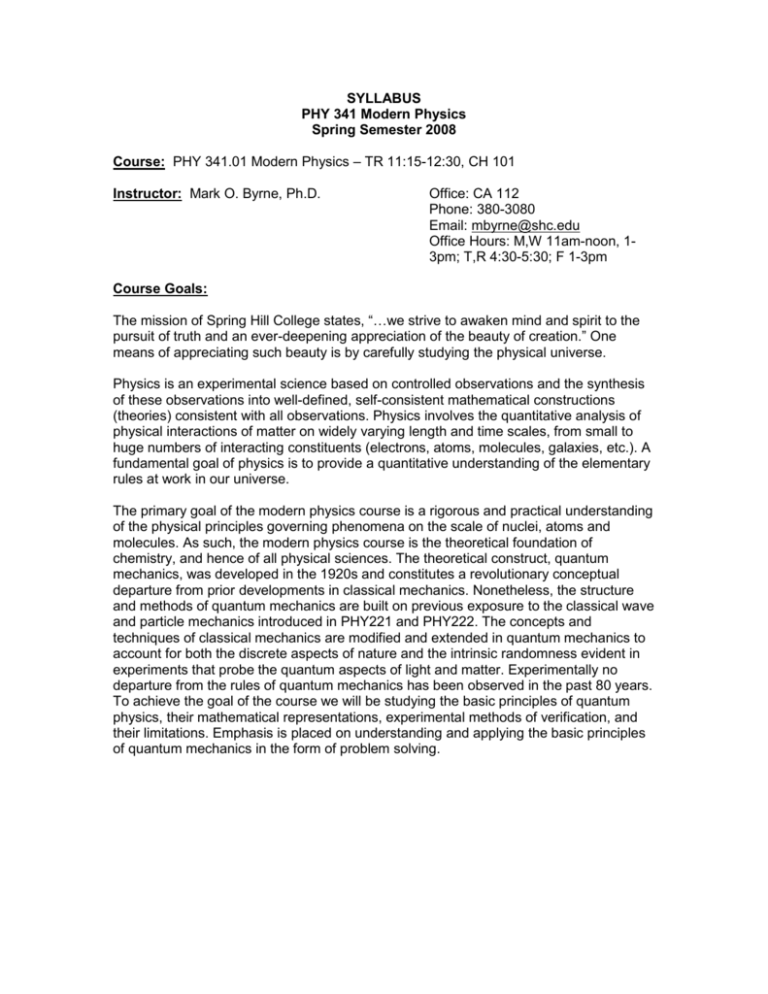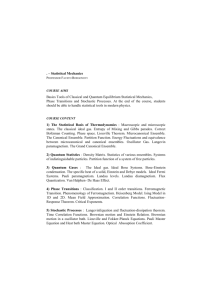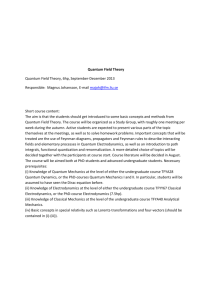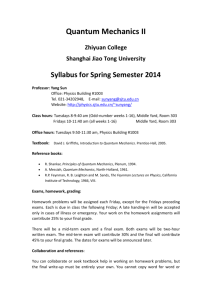
SYLLABUS
PHY 341 Modern Physics
Spring Semester 2008
Course: PHY 341.01 Modern Physics – TR 11:15-12:30, CH 101
Instructor: Mark O. Byrne, Ph.D.
Office: CA 112
Phone: 380-3080
Email: mbyrne@shc.edu
Office Hours: M,W 11am-noon, 13pm; T,R 4:30-5:30; F 1-3pm
Course Goals:
The mission of Spring Hill College states, “…we strive to awaken mind and spirit to the
pursuit of truth and an ever-deepening appreciation of the beauty of creation.” One
means of appreciating such beauty is by carefully studying the physical universe.
Physics is an experimental science based on controlled observations and the synthesis
of these observations into well-defined, self-consistent mathematical constructions
(theories) consistent with all observations. Physics involves the quantitative analysis of
physical interactions of matter on widely varying length and time scales, from small to
huge numbers of interacting constituents (electrons, atoms, molecules, galaxies, etc.). A
fundamental goal of physics is to provide a quantitative understanding of the elementary
rules at work in our universe.
The primary goal of the modern physics course is a rigorous and practical understanding
of the physical principles governing phenomena on the scale of nuclei, atoms and
molecules. As such, the modern physics course is the theoretical foundation of
chemistry, and hence of all physical sciences. The theoretical construct, quantum
mechanics, was developed in the 1920s and constitutes a revolutionary conceptual
departure from prior developments in classical mechanics. Nonetheless, the structure
and methods of quantum mechanics are built on previous exposure to the classical wave
and particle mechanics introduced in PHY221 and PHY222. The concepts and
techniques of classical mechanics are modified and extended in quantum mechanics to
account for both the discrete aspects of nature and the intrinsic randomness evident in
experiments that probe the quantum aspects of light and matter. Experimentally no
departure from the rules of quantum mechanics has been observed in the past 80 years.
To achieve the goal of the course we will be studying the basic principles of quantum
physics, their mathematical representations, experimental methods of verification, and
their limitations. Emphasis is placed on understanding and applying the basic principles
of quantum mechanics in the form of problem solving.
Course Description:
PHY 341 is organized around a basic principle – Education for the common good
of the global community.
PHY 341 is a one semester introductory course emphasizing the theoretical foundation
of quantum mechanics, although the course may also include special relativity and
applications of quantum mechanics in nuclear physics subject to student interest. The
course will discuss the motivation for introducing the non-relativistic Shrödinger
equation, the probabilistic interpretation, operator methods, the generalized uncertainty
principle, solution methods and solutions for different classical potentials, bound states
and scattering, formal mathematical developments (Hilbert spaces, eigenfunctions,
eigenvalues, Dirac notation), spin and orbital angular momentum, identical particles,
atoms and solids, quantum statistical mechanics, perturbation theory and the emission
and absorption of radiation.
Course Objectives:
After completion of PHY 341 and students will be able to
- demonstrate a clear understanding of the concepts of quantum mechanics,
- demonstrate a clear understanding of the non-relativistic Shrödinger Equation,
solution methods, and physical interpretations of solutions,
- demonstrate a clear understanding of the relationship between the theoretical
principles of quantum mechanics and their applications in atomic and
molecular dynamics as a basis for chemical and biochemical interactions,
- demonstrate a clear understanding of the relationship between the theoretical
principles of quantum mechanics and their applications to solids and gases,
- demonstrate competency in applying the mathematical formalism of quantum
mechanics to make physical predictions,
- demonstrate practical computational skills in a mathematical computing
environment (e.g., Mathematica, Matlab) – finding eigenvectors, eigenvalues,
graphical solutions, etc.
- demonstrate problem-solving skills,
- demonstrate the appropriate language of quantum mechanics, both in writing
and orally.
Course Administration: Prerequisite: PHY 222
1. Primary Text: Introduction to Quantum Mechanics (2nd ed.) by David J.
Griffiths, Pearson Prentice Hall, ISBN 0-13-111892-7
While there is a noticeable lack of references to other quantum texts in the primary text,
there are a large number of other excellent introductory quantum mechanics and modern
physics textbooks which you may find useful during (and after) the semester. This
course will be supplemented by readings from some of these texts, as appropriate. An
incomplete list is attached at the end of the syllabus. Students desiring an experimental
component (Millikan Oil Drop, Frank-Hertz, photoelectric effect, spectroscopy, particle
detector physics, semiconductor physics) may wish to use the text Experiments in
Modern Physics by Adrian C. Mellisinos, 1966, Academic Press Inc, ISBN 0-12489850-5 and consult with the instructor for acquisition of the appropriate materials and
laboratory time.
2. Evaluation
(a) Exams (40%) There will be two take-home examinations (each counting
20% of the final grade) during the semester consisting of problems of similar difficulty to
those assigned in the text during the semester. Each exam is intended to require no
more than two hours to complete.
(b) Final Exam (20%) The final exam will be a comprehensive examination on
topics covered throughout the semester.
(c) Homework (40%) Homework for each chapter must be turned in as
assigned and is graded for accuracy and completeness.
(d) Final Grade (average) = (0.2*Exam 1 + 0.2*Exam 2 + 0.2*Final Exam +
0.4*HW Average)
Grade Scale (%): A = 90-100, B = 80-89, C = 70-79, D = 60-69, F = 0-59. +
and – grades are given as appropriate as determined by the instructor.
(e) Make-up Exam Policy: Exams are given only when scheduled. No make up
exams and/or quizzes will be given.
4. Homework: Problems will be assigned for each chapter and are essential for
mastering the material. A listing of the assigned problems in the primary text is
attached.
5. Attendance Policy: Attendance is expected at every class. WP/WFs are given
rarely and only at the discretion of the instructor.
6. Policy Statement on Students with Disabilities: Students who wish to
receive disabilities accommodations should contact Mrs. Dunklin,
Coordinator for Student Support Services at 380-3470 as soon as possible
so that warranted accommodations can be arranged. Her office is located
in Student Academic Services, 1st Floor, Administration Building.
Schedule of Topics (Subject to variation at the discretion of instructor)
Week Month Dates
Chapter(s)
Topic(s)
1 Jan
10
NA
Classical mechanics/wave theory (review); Quantum Issues
2
15,17
1
Shrödinger equation, interpretation, probabilities
3
22,24
1,2
Operators/Uncertainty principle, Time-independent wave equation
4
29,31
2
Different potentials and solutions/Algebraic methods/ Free particle
5 Feb
7
2
Bound states and scattering
6
12,14
3
Formal theory - Hilbert space, eigenfunctions, eigenvalues, Dirac notation
7
19,21
3
Formal theory (cont'd)
8
26,28
4
Central Potentials, Angular Momentum
4
Spin, Spin 1/2, Addition of angular momenta
5
5
Spring Break
5
6
9
NA
9
Identical particles (Pauli exclusion, exchange forces), Atoms, Solids
Solids (cont'd), Band structure, Quantum Statistical Mechanics
9 March 4,6
10
11
12
13 April
14
15
16
17
11,13
18,20
1,3
8,10
15,17
22,24
29
Quantum Statistical Mechanics (cont'd)
Time-independent perturbation theory, Fine structure of Hydrogen
Time-dependent perturbation theory: two level systems
Student selected applications of QM
Emission and absorption of radiation
Final Exam: Tuesday, May 6th, 9:00-11:00am
Note: The Final Exam will be a comprehensive exam.
Homework Problem Sets (specfic problem assignments and
dates may be modified at the instructor's discretion)
Week
1
2
3
4
5
6
7
8
9
10
11
12
13
14
15
16
17
Chapter
NA
1
1
2
2
2,3
3
4
4
5
5
5
6
6,9
NA
9
Problem Set
Handout
1, 3, 5, 7 ,8
9, 11, 14, 15, 18
1, 2, 4, 5, 7
10,11,12, 22a-c, 26, 27
2.34, 2.46, 2.52(a), 3.2, 3.3, 3.4, 3.6
7, 10, 13,14,17, 22, 23, 38, 39
1a, 2, 3, 7, 11a, 13a, 16, 17
18, 19, 21, 24, 27-29, 55
4.35, 1,4,6,16,17
22, 23, 24, 30,31
Spring Break
35, 36
1, 2, 4, 7, 9
6.31, 9.1, 9.2
NA
8, 9,10, 19
Text: Introduction to Quantum Mechanics (2nd ed.) by David J. Griffiths
Supplemental Texts in Quantum Mechanics (Incomplete List)
Introductory texts
R. Shankar, Principles of Quantum Mechanics, 1994.
R.L. Liboff, Introductory Quantum Mechanics, 1980.
R.G. Winter, Quantum Physics, 1986.
L. Ballentine, Quantum Mechanics: Modern Developments, 1996.
R.W. Robinett, Quantum Mechanics: Classical Results, Modern Systems, and Visualized Examples, 2006.
D. Park, Introduction to the Quantum Theory, 1992.
A.P. French and E.F. Taylor, An Introduction to Quantum Physics, 1988.
R.P. Feynman, R.B. Leighton and M. Sands, The Feynman Lectures on Physics, volume 3, 1965.
D.T. Gillespie, A Quantum Mechanics Primer, 1973.
J. Townsend, A modern approach to quantum mechanics, 1992.
D. Bohm, Quantum Theory, 1951.
D.S. Saxon, Elementary Quantum Mechanics, 1968.
S. Gasiorowicz, Quantum Physics, 1996.
H.C. Ohanian, Principles of Quantum Mechanics, 1990.
Eisberg and Resnick, Quantum Physics of Atoms, Molecules, Soilds, Nuclei and Particles, 1985.
Advanced texts
E. Merzbacher, Quantum Mechanics, 1961.
C. Cohen-Tannoudji, B. Diu, F. Laloë, Quantum Mechanics, 2000.
J.J. Sakurai, Modern Quantum Mechanics, 1997.
A. Messiah, Quantum Mechanics, 1999.
G. Baym, Lectures on Quantum Mechanics, 1974.
L.I. Schiff, Quantum Mechanics, 1955.
L.D. Landau and E.M. Lifshitz, Quantum Mechanics, 1981.
P.A.M. Dirac, The Principles of Quantum Mechanics, 1982.
R.P. Feynman and A.R. Hibbs, Quantum Mechanics and Path Integrals, 1965.
Philosophical/Foundational issues
J.S. Bell, Speakable and Unspeakable in Quantum Mechanics (reprint collection), 1987.
B. d'Espagnat, Conceptual Foundations of Quantum Mechanics, 1976.
W. Heisenberg, Physics and Philosophy, 1962.
B.J. Hiley and F. D. Peat, Eds., Quantum Implications (essays), 1987.
M. Jammer, The Philosophy of Quantum Mechanics, 1974.
A.I.M. Rae, Quantum Physics, Illusion or Reality? 1986.









